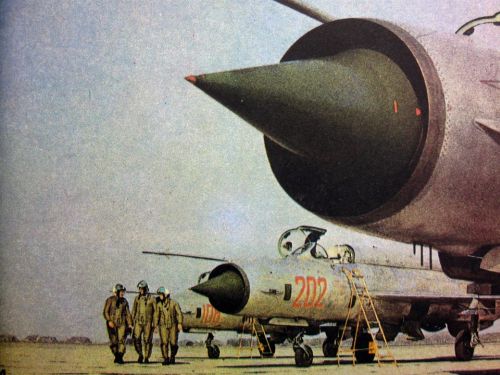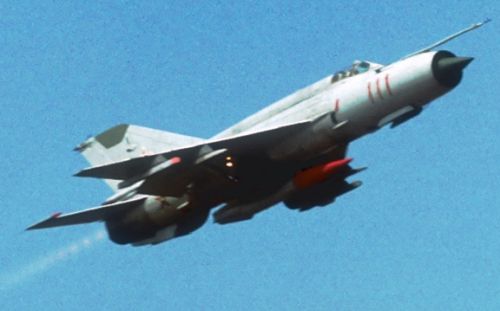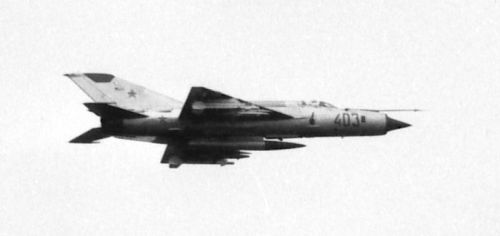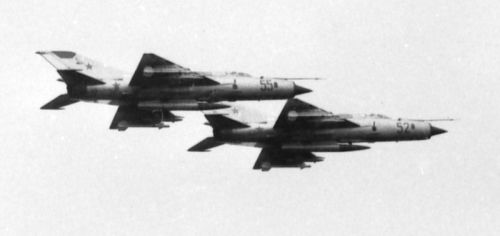|
|
 |
 |
|
Source: Aviation News incorporating Classic Aircraft January 2014
Evgeni Andonov and Alexander Mladenov
|
 |
 |
|
In the mid-1970s, the Warsaw Pact command authorities provided two of their more loyal member states, with access to tactical nuclear weapons. One of these nations was the People’s Republic of Bulgaria, along with Poland. Consequently, the country’s Protivovazdushna Otbrana i VoennoVazdushni Sili (PVOiVVS – Air Defence and Air Force) would need to master the art of deploying weapons of mass destruction, with help from the Soviet Union.
|
|
|
 |
 |
|
The PVOiVVS’s first nuclear-capable aircraft were a dozen MiG-21M Fishbed-Js (Type 96). Originally delivered to Bulgaria in 1969 and operated by 2/19 IAE (second squadron of the 19th Fighter Air Regiment), these supersonic jets were upgraded with new wiring and pylon adaptors in 1973/74 to perform their new role. Each could carry a single RN-28 nuclear bomb (popularly known as the Spetzbomba or ‘special bomb’) attached to its center line pylon with a BDZ-66-21N beam-type adaptor. The technical personnel of the 19th IAP (Iztrebitelen AvioPolk, Fighter Air Regiment) were tasked with scheduled maintenance of the aircraft’s nuclear systems and the nuclear bomb adaptor beams were stored in a separate restricted-access shelter. Initially, despite the availability of the nuclear-capable aircraft, no formal technician training for learning the procedures of installing either practice or live nuclear bombs was introduced.
|
|
 |
 |
|
Two years after the nuclear modifications, a group ofive highly experienced instructor pilots – two of them from the 19th Fighter Air Regiment and three from the Plovdiv-based 10th Composite Air Corps – underwent a training course on delivering the nuclear bombs with the Soviet Tactical Air Force’s 684th Guards Fighter Air Regiment, stationed at Tiraspol in Moldova, then a republic of the Soviet Union. The training focused on developing the necessary skills for dropping practice bombs in both level fight and by toss-bombing, although it is not known whether the Bulgarian pilots were ever given detailed information on the design and operating principles of the nuclear weapons. Later on, these Soviet-trained Bulgarian instructors taught other selected pilots from 2/19 Fighter Air Squadron in the methods of deploying the Spetzbomba.
|
 |
 |
|
Nuclear bombing methods
|
|
|
 |
 |
|
Lt Gen (Reserve, now retired) Stephan Popov, a former CO of the MiG-21-equipped 19th Fighter Air Regiment, recalls that the toss-bombing method was the most difficult to master and had two variations. The first called for the pilot to accelerate to 566kts (1,050km/h) at low level and then enter a 45° climb and releasing the weapon at 3,000m (9,842ft). They would then release the bomb, which would travel 3.8nm (7km) before impact. The second method required the bomb to be released while performing a looping maneuver, and gave a more precise delivery.
The pilot would accelerate in level flight to 566kts at a height of 100m (330ft), before pulling up into the loop.
|
|
 |
 |
|
All Bulgarian MiG-21M and MF Fishbed-J were wired to carry a nuclear bomb on a special adaptor, mounted on the under-fuselage pylon in place of the centre-line drop tank. This is a grey coloured MiG-21MF-75 Fishbed-J with red nose centre-line drop tank. Photo: Evgeni Andonov collection
|
 |
 |
|
Bomb release occurred with the nose just beyond the vertical, at a 106° pitch angle and an altitude of about 3,000m, giving an impact point directly below the release point. In both cases, after release the pilot immediately levelled the aircraft and engaged full power and afterburner, giving between one and two minutes to escape to a safe distance before detonation.
The toss-bombing method lacked precision; but to achieve a best-rated drop according to the evaluation system used in training exercises, pilots were required to deliver the bomb within a circle with a radius of 500m (1,640ft) from the target’s centre. Such a miss distance was considered more than adequate for the powerful nuclear blast to effectively destroy the majority of battlefield targets.
In the 1960s, the Balkan theatre of operations (the so-called Balkan fronts) was battle-planned for 30 nuclear munitions. During the mid-1970s, when Lt Gen (Ret) Popov attended the Soviet Union’s Gagarin Air Force Academy, Warsaw Pact plans called for the delivery of up to 600 individual tactical nuclear strikes in at least two waves. On Bulgarian territory, two separate fronts were to be established in the case of a strategic offensive against NATO forces deployed to the south in the Balkans, Turkey and Greece. Targets would have included any NATO platforms fitted with nuclear weapons, command and control centers, airfields, ports and ground forces.
|
 |
 |
|
The PVOiVVS’s nuclear strike force, represented by 2/19 Fighter Air Squadron, was later complemented by 20 MiG-21MFs (Type 96A/F), 15 of which had initially been delivered new to the 18th regiment at Dobrislavtzi near Sofia a in the mid-1970s (equipping 1/18 Fighter Air Squadron). In 1978, all these aircraft were handed over to the 19th regiment at Graf Ignatievo and taken on strength by 1/19 squadron.
|
 |
 |
|
Source: Aviation News incorporating Classic Aircraft January 2014, Evgeni Andonov and Alexander Mladenov
|
 |
 |
|
Tags:
Bulgarian Air Force, VVS, Cold War, Warsaw Pact, 10th Composite Air Corps, Plovdiv, 19th Fighter Air Regiment, Graf Ignatievo, MiG-21M, MiG-21MF Fishbed-J
Военновъздушни сили, ВВС, Военновъздушни сили на Република България, 10-и САК, 10-и Смесен авиационен корпус, Варшавски договор, Студена война, 19-ти изтребителен авиополк, 19-и ИАП, Граф Игнатиево, МиГ-21МФ, МиГ-21М
|
|





